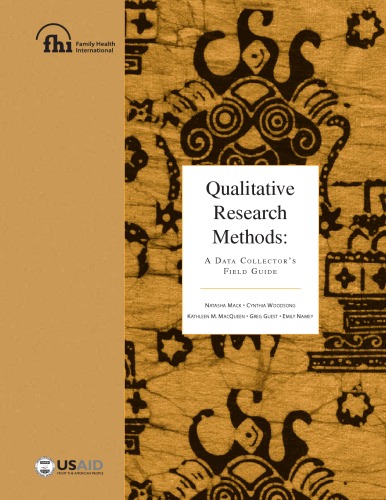

Most ebook files are in PDF format, so you can easily read them using various software such as Foxit Reader or directly on the Google Chrome browser.
Some ebook files are released by publishers in other formats such as .awz, .mobi, .epub, .fb2, etc. You may need to install specific software to read these formats on mobile/PC, such as Calibre.
Please read the tutorial at this link: https://ebookbell.com/faq
We offer FREE conversion to the popular formats you request; however, this may take some time. Therefore, right after payment, please email us, and we will try to provide the service as quickly as possible.
For some exceptional file formats or broken links (if any), please refrain from opening any disputes. Instead, email us first, and we will try to assist within a maximum of 6 hours.
EbookBell Team

5.0
40 reviews
ISBN 10: 0939704986
ISBN 13: 9780939704986
Author: Mariana Marin Chacon
This field guide is the creation of all the authors. However, we especially recognize Cynthia Woodsong as its originator and inspiration. It is she who began crafting training materials during the course of her many public health projects in field sites far and wide, as she sought to prepare teams for the immediate while equipping them with skills to collect data for other research proj- ects in the future. During these training experiences, she perceived a recurring need to provide field teams with foundational, practical information on qualitative methods, presented in a form that was self-contained, tangible, and easy to consult during the action moments of data collec- tion. Dr. Woodsong built upon her repertoire of need-to-know training materials with each suc- ceeding project. In turn, these materials, many of which she developed with funding from the U.S. National Institutes of Health, have provided the bulk of the substance for the present field guide. Too,Dr. Woodsong’s vision for capacity building in developing country settings remains our collective vision for this field guide. We would also like to recognize the conceptual contributions of Betsy Tolley and Lorie Broomhall. Their emphasis on the importance of allowing for individual approaches to preparing research teams for data collection served as a reminder that a practical field guide should not portend to be a training curriculum in and of itself. Rather than a replacement for hands-on interaction between trainers and data collection teams, we intend our guide to be a useful supplement for each team member as they learn and use qualitative methods in the field. Reviewers Betty Akumatey of the University of Ghana, Legon, and Joy Noel Baumgartner of FHI merit our sincere thanks as well. Their candid evaluations helped us measure our goal of developing a functional tool against the reality of whether it worked in the field. We thank also Beth Robinson for her encouragement, enthusiasm, and technical and personal support from the start of this project to its finish. Thank you to Larry Severy for his all-round backing of the proj- ect. Merrill Wolf, editor, is due thanks for the manuscript’s organization and flow, as is Karen Dickerson, copyeditor and designer, for her great attention to detail and consistency. Illustrations are credited to Denise Todloski. Kerry McLoughlin graciously stepped in at a moment’s notice to provide assistance with the case study examples. And Lucy Harber, our gentle, smiling produc- tion manager, was indispensable in ways immeasurable for bringing the project to fruition. This guide was made possible by funding from the U.S. Agency for International Development (USAID). We extend our gratitude for their unwavering support
Introduction
Case Study
Module 1 - Qualitative Research Methods Overview
Introduction to Qualitative Research
Comparing Quantitative and Qualitative Research
Sampling in Qualitative Research
Recruitment in Qualitative Research
Ethical Guidelines in Qualitative Research
Suggested Readings
Module 2 - Participant Observation
Overview of Participant Observation
Ethical Guidelines
Logistics of Participant Observation
How to Be an Effective Participant Observer Tips for Taking Field Notes
Suggested Readings
Case Study Samples
Participant Observation Steps
Module 3 - In-Depth Interviews
Overview of In-Depth Interviewing
Ethical Guidelines
Logistics of Interviewing
How to Be an Effective Interviewer
Tips for Taking Interview Notes
Suggested Readings
Case Study Samples
Interview Steps
Interview Checklist
Module 4 - Focus Groups
Overview of Focus Groups
Ethical Guidelines
Logistics of Focus Groups
How to Be an Effective Moderator
How to Be an Effective Note-taker Tips for Taking Focus Group Notes Suggested Readings
Case Study Samples
Module 5 - Data Documentation and Management: Organizing and Storing Your Data Converting Raw Data to Computer Files
Organizing Data Storage
Suggested Readings
Case Study Samples
Data Archiving Steps
Data Management Checklist
Appendix A: Exercises for Training Data Collectors
Appendix B: Tools for Data Managers
Glossary
quantitative and qualitative research methods
the sage encyclopedia of qualitative research methods
introduction to qualitative research methods
how to use and assess qualitative research methods
introduction to qualitative research methods a guidebook and resource
Tags: Mariana Marin Chacon, Qualitative research, collector's field